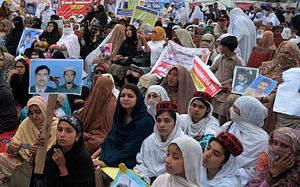On Sunday, thousands gathered in Peshawar, the capital of the Pashtun-dominated Khyber Pakhtunkhwa (KP) province of Pakistan, to protest against state oppression and human rights abuses that the ethnic minority has been facing for decades.
The rally, orchestrated by the Pashtun Tahafuz [Protection] Movement (PTM), had massive nationwide participation, especially from KP and the Federally Administered Tribal Areas (FATA). Echoes of “da sang azadi da” (“what kind of freedom is this”) reverberated as families of missing persons held up placards and banners demanding justice for their loved ones.
While the PTM is based on deep-rooted seeds of resentment, it sparked into an uprising following the extrajudicial killing of Naqeebullah Mehsud in January, which prompted a long march to the capital a couple of weeks later.
The PTM’s list of demands for the state includes punishing Mehsud’s killer – police officer Rao Anwar –halt in judicial killings, recovery of all missing persons, clearing FATA of land mines, and an end to humiliation at check-posts around the heavily militarized tribal region, which is a result of the age-old ethnic profiling of the Pashtuns.
The PTM is led by Manzoor Pashteen, a 26-year-old human rights activist from Waziristan, who pulls no punches in his criticism of the state or the all-powerful Army. Pashteen memorably said he won’t let the Pashtuns be tissue papers “that the Pakistani state uses – and then throws away.”
On Sunday, he orchestrated popular chants against the Army’s complicity in the spread of terrorism in the country, for which the Pashtuns – especially those in the tribal areas – have suffered most of the wrath in the shape of military operations that erased communities and left thousands homeless or completely missing.
It is owing to this vociferous delineation of brutalities against the Pashtun at the hands of Pakistan Army that there was a complete blackout of the rally in the local media, with only a few English publications providing any coverage.
Even though the Army spokesperson accepted the PTM’s grievances as “legitimate” in a press conference last month, calling Pashteen a “bright young man,” there has been active censorship of the movement under the instructions of the military establishment, considering how blatantly they challenge the state’s duplicitous security policies.
This has prompted many to dub PTM as “anti-Pakistan,” given that it refuses to see the state as based on monolithic jingoism. Hence the Pashtun protest movement is being shunned – just as Baloch nationalism has been for decades – as anti-state.
This false equivalence between a minority community’s demands for protection and the act of treason is founded upon the narrow “ideology of Pakistan” proliferated in local curricula and literature. It is reminiscent of 20th century European fascist states that needed propaganda tools to maintain unquestionable authority, or empires that had to fabricate commonalities to keep a stranglehold over the aggregate of peoples they ruled over.
Ironically, though, the PTM that can actually save Pakistan by finally redefining the very idea of nationalism that has plagued the state since 1947.
The rigid, paranoid, India-centric, Islam-mongering foundations of the state, which indeed owe a lot to the circumstances of its creation, can forever be trashed and replaced with a pluralistic idea of a Pakistani nation that embraces its multiethnic and multireligious existence without coercing a “true Pakistani” prototype that requires shunning of racial or ideological differences.
This prototype has been welded together by the imposition of Urdu and Islam – neither of which is indigenous – as an “inalienable” part of Pakistani nationalism, prompting the forcible purge of all other identities, including linguistic and cultural – as wholeheartedly embraced and propounded by the Punjabi majority.
Pakistan should know the consequences of dismissing the grievances of an ethnic minority better than anyone, having had to part ways with its eastern wing, now known as Bangladesh, in 1971. While Baloch and Pashtun nationalism movements do not have similar geographical disparity, should all centrifugal forces apply themselves in unison, the outdated idea of Pakistan would self-implode anyway.
Therefore, Pakistan’s own progress hinges on addressing the PTM grievances. For only by accepting the fact that the tribal areas have been ill-treated can FATA finally be merged into “mainstream” Pakistan, which the locals have been demanding for decades.
It is by finally repairing its social contract with the Pashtuns that Pakistan would be able to fix its relations with Afghanistan, which the state has long viewed through Islamist, India-tinted glasses as its “fifth province.”
Acknowledging Afghan sovereignty might help Pakistan recognize its own as well, considering that it has been given on lease to jihadist groups, which the state has long mistaken as strategic assets.
Most importantly, at the heart of embracing the Pashtun nationalist movement lies the revision of the state’s security policies and abandonment of internal and external jihad, which remains an existential threat to Pakistan itself, not merely to its idea.
































